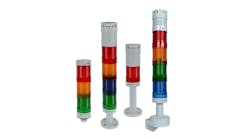One of the first things I implemented when I joined my current employer nearly 12 years ago was a standard for the deployment and use of stack lights on packaging equipment. The point of this standard was to unify the way in which our various equipment was sending messages to the operators.
Packaging lines can tend to be busy with various units of operation all clamoring for attention to keep them in operation or resume operation after a stop. For an individual machine, a simple red for stop and green for go might be sufficient but in a 20-by-60-ft room with six individual machines contributing to the manufacturing process, the change in status of a simple stack light might not garner the attention it needs. The additional downtime created by this confusion equals loss of production and loss of revenue.
Most machine vendors come up with creative ways to make their particular operation stand out from an informational standpoint. The simplest way to draw more attention is to add sound to the equation. Perhaps make a sound when a fault occurs or when a piece of equipment is starting up. Some vendors make it a short burst, some a long burst, and others might make it sound continuously until someone takes notice and responds to the problem. Other vendors choose to make their sounds louder than the other guys’ sounds.
Sound tends to bounce off solid objects or get deflected by machine guarding and the desired call to action is lost in the forest of equipment. Pretty soon, like the light beacons in a busy room, the noise becomes such a clatter that the operators start to tune out the sounds as too much information.
So, how do we make our machine or operation stand out? Perhaps a bigger beacon would make sense. How about a horn instead of a buzzer? How about a fog horn?
Our solution to this matter was to put the same stack-light arrangement on every unit op and change the programmed functions so that each machine used the same set of lights and buzzers to represent the same conditions, regardless of the function of the machine.
We settled on the following light designations:
- Solid red means an e-stop or other guard is currently activated.
- Flashing red means a fault has occurred and is still active.
- Solid yellow is jog or manual mode active.
- Flashing yellow means the machine is moving/cycling while in jog/manual mode.
- Solid green is machine running in automatic.
- Flashing green means machine is starting or the machine is in automatic but is suspended due to a downstream device not currently running.
Blue is for materials:
- A flashing blue light means a necessary material source, such as glue or carton/web supply, is low.
- A solid blue light means that the source is below minimum level.
The sound module on the stack light was also used to signal conditions:
- Machine startup is three beeps at 1-second intervals.
- Three seconds continuous means a fault has occurred.
- A continuous double-beep, along with the blue flashing light, means that a material supply is getting low.
By using the same stack light product on each unit op, every machine in the room gets equal billing. No machine can overpower an adjacent machine, as far as drawing attention to the operator. The similar position of each color on the stack light creates familiarity and allows the operator to quickly identify a particular unit op in need of attention with the appearance of an out-of-place light.
This new system contributes to the process of a visual factory where annunciation is common across the operation and accentuates familiarity where a light pattern or sound pattern means the same thing regardless of the machine on which it is mounted.
There is a downside to this, however. Now we have created a situation where everything sounds and appears like everything else. We no longer have a signal system overpowering an adjacent system, but we have nothing to distinguish them either.
We solved some of the sameness with the use of the flashing green lights. The unit op that has stopped with a fault/guard issue will have a solid, or flashing, red light. All of the other unit ops will have a flashing green light to indicate that something downstream has stopped the process.
We further added some distinctness by varying the duration and pattern of the beeps for when a fault occurs, or low-material warning. Sadly, though, there is only so much that can be done with a common set of lights and fixed decibel output on a horn.
Happily, some vendors have come up with a way to juice up the function of stack lights by putting some smarts into them. Programmable stack lights have additional functions, including being able to combine colors to create a wider range of colors than the single-bulb versions. Additionally, most smart stack lights also have a selectable range of alarm outputs in various decibels and patterns in ways that a programmable logic controller (PLC) output would not be able to accomplish.
The most popular versions of a smart stack light come in two flavors. One employs IO-Link to trigger programmed functions, while the other requires programming via software to set it up and then trigger via digital, wired signals. With costs being similar, the choice is really up to the designer.
The options available for use are quite diverse. Dependent on programming selection, a multi-segment stack light can be set up where each segment can have a particular behavior.
One vendor offers the following options—off, steady, flash, two-color flash, 50/50, 50/50 rotate, chase or intensity sweep.
Off, steady and flash seem obvious but let’s look at some of the other options. Any time a flash function is desired, the programmer has control over the speed, intensity and pattern of the flash. Two-color flash alternates two colors but with the options of speed, intensity and pattern for each.
The 50/50 option provides two colors on the same segment with half of each segment in the programmed color. 50/50 rotate is the same as 50/50 but the colors rotate around the segment at a speed, intensity and direction as programmed. The chase function uses one color as the base, or background, and the other color rotates around the segment as a spot against the background color. Intensity sweep increases and decreases the intensity of a single color from 0 to 100% at a defined speed and color intensity.
The stack light can also be configured so that all segments can be involved in the animation. Additional functions like scroll, bounce and color spectrum are involved. Scroll illuminates two segments in a common color and moves them up and down the rest of the stack against a chosen second color with speed, intensity and single direction selectable.
Bounce is similar but moves the first color both up and down through the second color background. Color spectrum scrolls through multiple pre-defined colors with a different color on each segment with defined speed, intensity and rotational direction.
This same smart stack light has options on the audible alarm module for off, steady, pulsed (50/50 duty cycle) and SOS pattern. While this does provide some variation, the module output is a single decibel value so numerous stack lights in the same room would all sound the same.
As one can imagine, the possibilities are far beyond a typical three-, four- or five-segment stack light. The point of these additional capabilities is to expand the available information in a visual manner, without having to go to the machine and look at an operator terminal. Something to keep in mind, with all this additional functionality, we run the risk of overwhelming the operator. Do we get to a point of information overload?
In my situation, on a packaging line with five-unit ops, which is average, having a common stack light for all the unit ops made lots of sense. Our main complaint since implementing this system was the desire to have different sounds from the various unit ops because the primary attention grabber is the sound module going off.
If we could have five different sounds, then the operator is more likely to glance in the correct direction when the audible alarm goes off and then use the status of the light segments to help determine an appropriate response prior to moving toward the trouble spot.
A different vendor in the marketplace has picked up on such a need and offers a programmable stack light with 21 colors and 11 alarms, all in a single part number. The audible alarms are selectable at 2,400, 3,600, 4,000 and 4,800 Hz with combinations of continuous and intermittent within those ranges. Yet another vendor has a stack light that can record and play back sound bites.
The interesting part about the smart stack light is the variety of approaches to the problem. Stack lights have always been a static, binary-state device where one has off-on functionality, and we add color segments to increase the information that could be produced.
Some programmers would get creative and use the physical characteristics of the audible device and produce some very unique sounds but the days of such creativity seem to be behind us. With the products being produced today, the designer can choose from self-contained programming by using buttons on the device, USB-connected programming software or direct networked connectivity such as IO-Link to produce seemingly limitless ways to draw attention on the production floor. Interesting times indeed.





